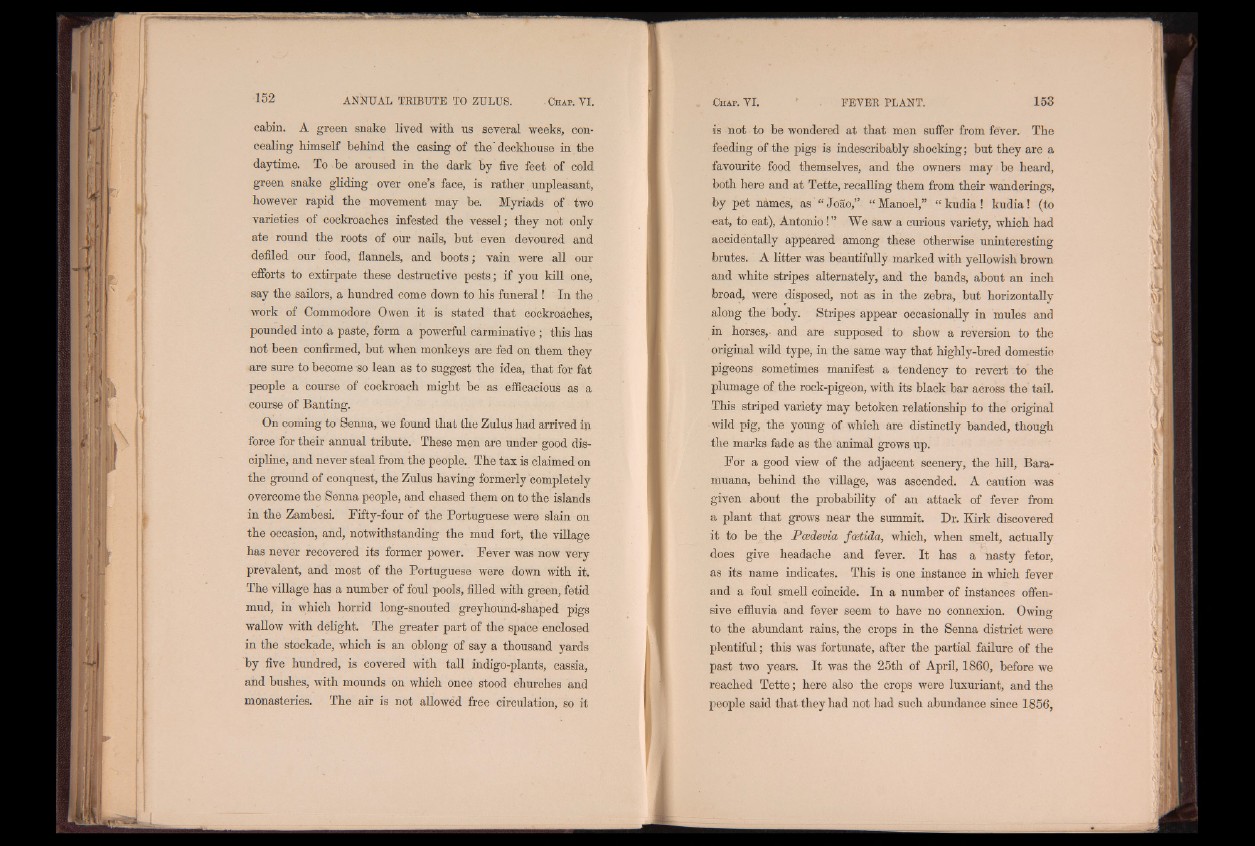
cabin. A green snake lived with us several weeks, concealing
himself behind the casing of the'deckhouse in the
daytime. To be aroused in the dark by five feet of cold
green snake gliding over one’s face, is rather unpleasant,
however rapid the movement may be. Myriads of two
varieties of cockroaches infested the vessel; they not only
ate round the roots of our nails, but even devoured and
defiled our food, flannels, and boots; vain were all our
efforts to extirpate these destructive pests ; if you kill one,
say the sailors, a hundred come down to his funeral! In the
work of Commodore Owen it is stated that cockroaches,
pounded into a paste, form a powerful carminative; this has
not been confirmed, but when monkeys are fed on them they
are sure to become so lean as to suggest the idea, that for fat
people a course of cockroach might be as efficacious as a
course of Banting.
On coming to Senna, we found that the Zulus had arrived in
force for their annual tribute. These men are under good discipline,
and never steal from the people. The tax is claimed on
the ground of conquest, the Zulus having formerly completely
overcome the Senna people, and chased them on to the islands
in the Zambesi. Fifty-four of the Portuguese were slain 0n
the occasion, and, notwithstanding the mud fort, the village
has never recovered its former power. Fever was now very
prevalent, and most of the Portuguese were down with it.
The village has a number of foul pools, filled with green, fetid
mud, in which horrid long-snouted greyhound-shaped pigs
wallow with delight. The greater part of the space enclosed
in the stockade, which is an oblong of say a thousand yards
by five hundred, is covered with tall indigo-plants, cassia,
and bushes, with mounds on which once stood churches and
monasteries. The air is not allowed free circulation, so it
is not to be wondered at that men suffer from fever. The
feeding of the pigs is indescribably shocking; but they are a
favourite food themselves, and the owners may be heard,
both here and at Tette, recalling them from their wanderings,
by pet names, as “ Joao,” “ Manoel,” “ kudia! kudia! (to
eat, to eat), Antonio!” We saw a curious variety, which had
accidentally appeared among these otherwise uninteresting
brutes. A litter was beautifully marked with yellowish brown
and white stripes alternately, and the bands, about an inch
broad, were disposed, not as in the zebra, but horizontally
along the body. Stripes appear occasionally in mules and
in horses,- and are supposed to show a reversion to the
original wild type, in the same way that highly-bred domestic
pigeons sometimes manifest a tendency to revert to the
plumage of the rock-pigeon, with its black bar across the tail.
This striped variety may betoken relationship to the original
wild pig, the young of which are distinctly banded, though
the marks fade as the animal grows up.
For a good view of the adjacent scenery, the hill, Bara-
muana, behind the village, was ascended. A caution was
given about the probability of an attack of fever from
a plant that grows near the summit. Dr. Kirk discovered
it to be the Pcedevia fcetida, which, when smelt, actually
does give headache and fever. I t has a nasty fetor,
as its name indicates. This is one instance in which fever
and a foul smell coincide. In a number of instances offensive
effluvia and fever seem to have no connexion. Owing
to the abundant rains, the crops in the Senna district were
plentiful; this was fortunate, after the partial failure of the
past two years. It was the 25th of April, 1860, before we
reached Tette; here also the crops were luxuriant, and the
people said that they had not had such abundance since 1856,